Land Invertebrates
Media
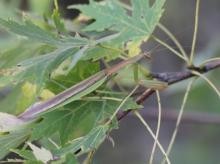
Species Types
Scientific Name
Tenodera sinensis (formerly T. aridifolia)
Description
The Chinese mantis is a large, green and tan ambush predator. This nonnative insect is often called a “praying mantis” because the front legs resemble hands folded in prayer.
Media
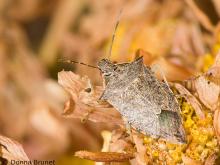
Species Types
Scientific Name
In North America, more than 200 species in 64 genera
Description
Stink bugs are shield-shaped insects that can smell really bad. This is a large family of true bugs known for producing a foul odor when harassed.
Media
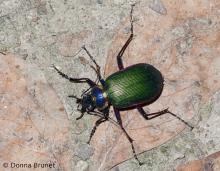
Species Types
Scientific Name
About 2,400 species in North America north of Mexico
Description
Ground beetles are a family of mostly nocturnal or light-shunning beetles that tend to be shiny black and have grooved wing covers. This group also includes tiger beetles, however, which includes many colorful daytime fliers.
Media
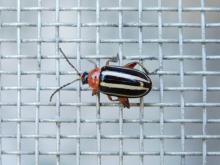
Species Types
Scientific Name
About 2,000 species in North America
Description
Leaf beetles, or chrysomelid beetles, are members of a large, diverse, often very colorful beetle family. As the name suggests, they eat leaves and other plant parts and are common on foliage.
Media

Species Types
Scientific Name
Popillia japonica
Description
Despite its decorative bronze wing shields, metallic green thorax, and black-and-white striped abdomen, the Japanese beetle is a serious agricultural pest.
Media
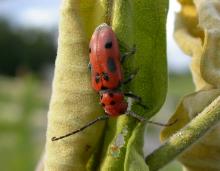
Species Types
Scientific Name
About 1,000 species in North America north of Mexico
Description
Longhorned beetles are elongated and cylindrical, with antennae that are at least half the length of the body — sometimes much longer. The larvae are grubs that bore in wood or other plants. Some are serious pests.
Media
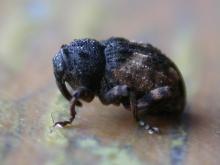
Species Types
Scientific Name
About 2,500 species in North America north of Mexico
Description
Weevils are plant-eating beetles with a characteristic long, down-curving snout. The antennae are clubbed and elbowed. There are thousands of weevil species.
Media

Species Types
Scientific Name
More than 400 species in North America north of Mexico
Description
The name is a warning: blister beetles are famous for their chemical defenses. Beetles in this family can exude an oil that can cause a person’s skin to blister.
Media

Species Types
Scientific Name
About 85 species in North America north of Mexico
Description
Green lacewings are delicate insects whose larvae are ravenous predators of aphids. This makes the lacewing a friend to gardeners!
Media

Species Types
Scientific Name
Neoscona spp.
Description
Missouri's Neoscona spiders, called spotted orbweavers, can be hard to identify to species. Most have camouflage patterns, and they all make the characteristic, delicate, wheel-shaped webs to catch prey.
See Also



Media

Species Types
Scientific Name
Cisseps fulvicollis
Description
The yellow-collared scape moth is more often “orange-collared.” And whether you think it looks more like a firefly or a wasp, it’s still a moth!
Media

Species Types
Scientific Name
Nearly 150 species in North America north of Mexico
Description
Slim, delicate plume moths are instantly recognizable by their T-shaped silhouette, long legs, and muted shades of tan and brown. It can be hard to separate the various species.
Media

Species Types
Scientific Name
Pyrrharctia isabella
Description
Not many people know the adult Isabella tiger moth when they see one, but we’re all acquainted with its caterpillar, the woolly worm, or woolly bear.
About Land Invertebrates in Missouri
Invertebrates are animals without backbones, including earthworms, slugs, snails, and arthropods. Arthropods—invertebrates with “jointed legs” — are a group of invertebrates that includes crayfish, shrimp, millipedes, centipedes, mites, spiders, and insects. There may be as many as 10 million species of insects alive on earth today, and they probably constitute more than 90 percent all animal species.





















